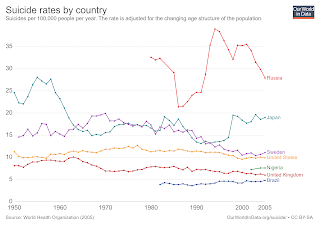With a cultural focus on honor and tradition, how does the suicide rate continue to climb, not only in Japan, but also around the globe? As one of the most technologically advanced countries, many may wonder why people feel the need to kill themselves. Many Japanese people are overworked, with one woman “[committing] suicide on Christmas Day in 2015 by jumping from a corporate dormitory. She had worked 100 hours of overtime the month before. She tweeted that year, ‘When you’re in the office 20 hours a day, you don’t understand what life you’re living for anymore. It’s so pathetic … you come to laugh.’” The Japanese even have a word for suicide caused by overwork, karojisatsu. One of the Japanese ministers of finance reportedly hung himself on World Suicide Prevention Day.
| Aokigahara Forest - India Times |
In Japanese mythology, the Aokigahara forest is “considered to be one of the most haunted places in all of Japan,” and many believe it is the home of demons and spirits who had unnatural and/or violent deaths. This forest lies at the foot of Mount Fuji and “was honored as the sacred embodiment of the divine creativity that had thrust the land up from the sea.” In The Complete Manual Of Suicide (published 1993) by Wataru Tsurumi, the Aokigahara Forest is called, “the perfect place to die.”
When nature is viewed with such reverence and a focus on the life force as a means of celebration in Shintoism, it creates an interesting conundrum. And for those who don’t believe in supernatural beings, GPS’s, phones, and compasses all act abnormally within the reaches of Aokigahara due to “rich deposits of magnetic irons created by volcanic soil in the region”
 |
| Suicide victim's shoes |
Japanese suicide rates are high, around 30,000 deaths per year. Many areas globally have stopped publishing their suicide rates and information about when a victim is found because authorities don’t want to give ideas to those struggling and who want to kill themselves. Resources in every country have been put in place to help people but the problem is many people are afraid to reach out for help or don’t see the point in trying anymore. Original Shinto beliefs concerning death were dark and included the idea of a river separating the living from the dead, much like the Greek River Styx leading to the Underworld, realm of Hades. With Buddhist influence, death became more of something to meditate on and the Japanese taught that life should be celebrated and enjoyed and made meaningful by word and action. Traditions of mourning include only showing grief on one particular day and the rest of the time the Japanese are expected to be almost stoic in their regards to show honor to those who have passed on.
Although in pop culture and in the news, we hear more and more about teen suicide rates, they are not the only ones faced with mental illnesses nor are they the only ones overworked. In fact, a rise in elderly suicides, especially in Japan, has become apparent. Although in the cases of the elderly, suicide is not usually due to overwork but loneliness. “The first time it drew national attention, the corpse of a 69-year-old man… had been lying on the floor for three years, without anyone noticing his absence. His monthly rent and utilities had been withdrawn automatically from his bank account. Finally, after his savings were depleted in 2000, the authorities came to the apartment and found his skeleton near the kitchen, its flesh picked clean by maggots and beetles, just a few feet away from his next-door neighbors.” In the old day in Japan, suicide was mainly known as a samurai’s act, as in Seppuku or hara-kiri.
The National Suicide Prevention Lifeline is 1-800-273-8255.
Please, if you or someone you know is suffering with depression or suicidal thoughts, get help before it is too late. In the words of Benedict Cumberbatch’s Sherlock Holmes, “Taking you own life. Interesting expression — taking it from who? Once it’s over, it’s not you who’ll miss it. Your own death is something that happens to everybody else. Your life is not your own. Keep your hands off it.”

No comments:
Post a Comment